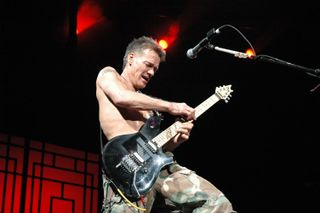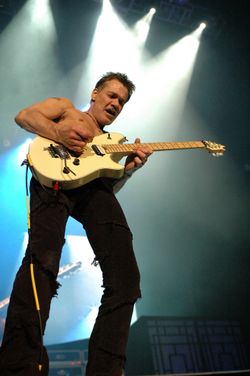Variety has a new story on Eddie Van Halen:

It’s an intense, visceral thrill to stand next to Eddie Van Halen while he plays a series of riffs that pass at whip-cracking speed, each note articulated with clarity and purpose. The sound and the force of the music are unmistakable; he looks up while strumming an open chord at length, shouting that he’s playing the runs that other guitarists could not figure out in the 1970s. I assume he is referring to his use of harmonics in the middle of a run with the occasional bent note.
The song he is playing is a new one, a possibility for the next Van Halen album, work on which is expected to start in the summer. The tune makes effective use of his patented detuner, a metal bracket the size of a Tic-Tacs box at the tail of the guitar that alters the key he is playing in. He yanks on the device, the tonal quality shifts and I immediately hear a Pete Townshend influence. When he finishes, Van Halen’s comment is “it’s got an old Who thing in there.” It’s good to know we’re on the same page.
Van Halen, the greatest hard rock guitarist since Jimmy Page, is for once not talking about lead singers, reunions or his personal life. The subject is the guitar, specifically the introduction of the EVH line by Fender. Van Halen’s famous guitars, especially his “Frankenstrat” with the red, black and white stripes, have been duplicated by manufacturers, but the new instrument — called the Wolfgang — is the first to be design by Van Halen with Fender’s team of designers.
He took four prototypes on the road during the last Van Halen tour, tweaking, redesigning and reworking the instrument until Van Halen put his stamp of approval on it. Fender says it has worked more extensively with Van Halen to design this six-string electric than any other instrument in its catalog; Eddie says he wants to offer consumers the exact same instrument he plays onstage.
“What they do with it is up to them,” he said. “They won’t necessarily sound like me. I hope they’ll do something different.

“A lot of companies rest on what they designed in the ‘50s. Not that there’s anything wrong with that, but I like to squeeze out everything out of every idea. I have the painstaking job of making it work. It’s like writing a song — why do (I hear in my head) stuff that is harder to play than to hum. To get the patent, then get someone to believe that it works is insane, too.”
AT 54, Edward Lodewijk Van Halen is still not a big picture guy. He does not encapsulate what his playing means to generation of followers, of how guitar design fits within his legacy or even pinpointing the differences between his approach to the David Lee Roth material the first time around and again 20-odd years later. What he is remarkably capable of doing is remembering precisely how he recorded a specific sound, what went into building a guitar from factory seconds and the tweaks he has done over the years to everything from the screws to the tuning pegs.
Visitors who enter Van Halen’s 5150 studio are encouraged to walk around the performance area to understand how vastly different every space in the studio sounds. He not only is aware of the sonic differences — and the space would be cramped if a five-piece rock band were set up in it — he employs that knowledge in the way he makes recordings.
“It’s very basic, the way I mike things. I hate to say it, but it’s different from the ways others do it. I want the sound as pure as possible.”
That credo, which Van Halen has lived by for three decades, has played a key role in keeping the Van Halen sound distinct from others. His band, though, is at a crossroads. A 2007-08 reunion with David Lee Roth pulled in $93 million for 74 dates, evidence the demand remains for classic Van Halen material. They have not released an album of new material in the digital age, which makes the release of the EVH guitar seem more relevant in that desire to connect the artist with the fan. It’s an expensive route, but it takes the iconic and makes it lifesize. These days, that’s a path for survival in the music industry.
Here’s a few of Eddie’s other comments:
(His favorite analogy): It’s kinda like a race car. My brother and I race all the time. It’s a very fine line between how one person will do it and another – you experiment until your lap time improves. It’s similar to reaching that elusive sound in your head.
Lets say your best lap time is 1:22. I’m down to 1:25 – only a few seconds behind, but in a race a long time. Say the guitar is at a 1:25, so the increments are more difficult. Going from 1:35 to 1:30 is easy if you have a natural instinct. Once you get down to (a competitive speed) no stone can be left unturned. Every little tiny aspect – tire pressure, what tires you use and how you brake.It all applies to the guitar. To make a better guitar, you really have to analyze every little thing if you want high performance guitar.
(What makes his guitar unique): Placement of the pickup is important. I measure with my finger. It’s got to be at a specific harmonic. On a dissonant harmonic, I’d get a weird sound. Also potting pickups. I was the first one to do that, dipping a pickup in wax. Most guitars only have one truss rod. The Wolfgang has two on the sides, one down the middle. I prefer bolt on necks.
Everything has been upgraded to highest quality. It took long time to find the pieces to put it together. This is all identical to what I use. I’m not out to prove jackshit. I need what I hear in my head.
(He takes two guitars off the wall to have me feel the necks).
I don’t have my necks sealed. The ones that will be sold will have a little oil. My guitars only have my natural skin oil. Your own oil is so much better than any synthetic. Depending on how much you play, in six to 10 months it will feel 10 times better than any other guitar. That’s why I don’t like anyone playing my guitars. I never clean them. A Wolfgang is a down and dirty, heavy-duty precise instrument that will hold up against anything you do to it.
(On recording): Very basic. It’s all in the way I mic things. It sounds brght over here, sounds dead over there. I used six mics on Alex’s drums once. Andy Johns walks in because he could only hear it and couldn’t see what was going on. ‘That’s an amazing drum sound,’ he says. ‘How’d you do that?’ I got on a ladder and listened everywhere. I hate to say it but its different from the ways others do it. Engineers know their pro-tools but don’t trust their ears. I don’t EQ. The more EQ you use and then try to remove it, you make it worse.
(His disdain for compression): On the radio, they compress more. So if you compress too much on the master, it will sound like shit on the radio. I tend to try to not compress. It’s a gamble, a throw of the dice out there on the radio. I want the sound pure as possible. Compression tends to make the loudest thing stand out and that’s usually the kick drum. Again all I go by is what sounds good to me. That applies to my instruments.